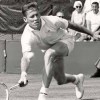By Randy Walker
@TennisPublisher
Just about anyone in the world over the age of 60 can probably answer the question where they exactly were on November 22, 1963.
This day was, of course, one of the most horrible days in American history as President John F. Kennedy was shot and killed in Dallas. The people of the United States – and the world – were stunned not only with the tragedy but aghast with the astonishing sights and events that ensued, including the sudden inauguration of President Lyndon Johnson on Air Force One, the murder of Kennedy’s alleged assassin Lee Harvey Oswald and the President’s sorrowful state funeral.
In the world of sports, the National Football League controversially proceeded with its full schedule of games just two days after Kennedy’s death. This was a decision that NFL Commissioner Pete Rozelle struggled with, but was re-assured of by Kennedy’s press secretary Pierre Salinger.
The world of tennis was still five years away from the more structured “Open Era” of professional tennis, but the focus of American tennis at the time was in Australia as the amateur members of the U.S. Davis Cup team were competing in events leading into their Davis Cup final against Australia, then called the Challenge Round.
Dennis Ralston, then a 21-year-old student at the University of Southern California and a top 10 amateur ranked player in the world, learned of Kennedy’s death while in Adelaide, Australia on the morning of November 23, the day he was scheduled to play John Newcombe in the final of the South Australian Tennis Championships in Adelaide.
Ralston recalled this week that he first heard of Kennedy’s death while staying at the Travel Lodge in Adelaide and listening to the morning news and first thinking that the news broadcast was a hoax.
“I thought it was another ‘War of the Worlds’ broadcast but I realized it was real and that something bad had happened,” Ralston said.
Heart-sick over the news of the President’s death, Ralston was unsure he wanted to or should play the final, but he was urged to take the court by U.S. Ambassador to Australia William Battle, a close friend of Kennedy’s, who assured Ralston that the President would have wanted him to take the court and play the final.
“I wasn’t too enthused about playing,” Ralston recollected 50 years later. “Everything was in a turmoil. I didn’t think that something like that would ever happen in the U.S. We certainly were not prepared for it.”
In his fragile mental state, Ralston was defeated in the South Australian final by the future three-time Wimbledon champion Newcombe 6-1, 6-3, 15-17, 6-1.
“Our entire team was distressed over the news of the President’s assassination,” Robert Kelleher, the captain of the U.S. Davis Cup team, said after the final to local reporters. “Denny didn’t know whether he should play or not.”
Ralston, however, would come through for his grieving nation a month later, where, on the very same court in Adelaide, Ralston and Newcombe met again in the opening rubber of the USA vs. Australia Davis Cup Challenge Round. Ralston reversed his result from the previous month claiming a 6-4, 6-1, 3-6, 4-6, 7-5 win over Newcombe in a match that proved critical to the United States winning back the Davis Cup with an eventual 3-2 victory, ending Australia’s four-year reign champions.
To read more daily anecdotes and match summaries from tennis history, order my THIS DAY IN TENNIS HISTORY mobile app and book at www.TennisHistoryApp.com.

